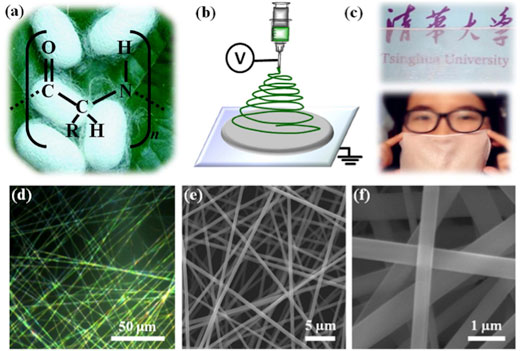| Posted: Jul 13, 2016 | |
Towards green, lightweight and highly efficient silk nanofiber-based air filters |
|
| (Nanowerk Spotlight) The serious threat of particulate matter (PM) air pollution to human health spurs development of advanced filter technologies. Particular efforts have been made in designing air filters with both high filtration efficiency and low airflow resistance by utilizing carbon nanotubes (CNTs) and electrospun polymer and inorganic nanofibers. | |
| To date, the development of CNT-based air filters is confronted by two main challenges: difficulty in fabrication and, more critically, unclear toxicity of CNTs. The fabrication of electrospun nanofibers lacks environmental safety and biological compatibility. | |
| To address these issues, a research team led by Yingying Zhang, Assistant Professor in the Department of Chemistry and the Center for Nano and Micro Mechanics, Tsinghua University, has utilized biocompatible, environmentally sustainable, and widely available natural silk fibers to fabricate silk nanofibers via the electrospinning approach. The scientists explored the performance of silk nanofiber membranes as air filters, which showed both of lightweight and high efficient features. | |
| They reported their findings in the June 27, 2016 online edition of Nano Research ("Silk nanofibers as high efficient and lightweight air filter"). | |
| Specifically, the team's membranes of electrospun silk nanofibers are made from silkworm cocoons, which is a kind of green and biocompatible natural material. The resulting silk nanofiber air filters showed combined features of high filtration efficiency for both PM2.5 (2.5 micron and above) and more harmful sub-micron particles, low air flow resistance (low pressure drop) and lightweight, making them very attractive for fabrication of personal air filtration devices. | |
 |
|
| Fabrication of the silk nanofiber-based air filter. (a) Silkworm cocoons are used as raw materials, and the molecular formula of silk protein is shown. (b) Schematic showing fabrication of the silk nanofiber-based air filter by electrospinning. (c) Example photographs of silk nanofiber-coated silk scarves as lightweight wearable air filters. (d) Optical image of silk nanofibers. (e) and (f) Scanning electron microscope (SEM) images of silk nanofibers, showing the detailed morphologies. | |
| In their work, the team demonstrated the superior performance of the silk nanofiber air fibers. By controlling the electrospinning time, the silk nanofiber membranes could show filtration efficiency of 98.8% for PM2.5 and 96.2% for 300-nm particles with a lower pressure drop than commercial microfiber membranes with comparable filtration efficiency. | |
| In addition, the silk nanofiber membrane is lightweight with a basis weight of only 3.4 g/m2, about 1/60th of a typical commercial respirator with similar filtration efficiency, which is highly desired for personal air filtration devices such as respirators. | |
| Furthermore, multifunctional silk nanofiber filters could be designed and fabricated by introducing functional components into the spinning solution. As a proof of concept, the silver nanoparticles, which are well-known broad-spectrum antibacterial agents, could be in situ incorporated into the spinning solution and subsequently electrospun into silk nanofibers, thereby introducing antibacterial activity into the silk nanofiber based air filters. | |
| Going forward, the team will work on the development of technology for the fabrication of low-cost and large-scale silk nanofiber air filters, further improving the filtration performance and the incorporation of other functionality such as degradation of formaldehyde. | |
|
By Chunya Wang ([email protected]), Tsinghua University
|
|
|
Become a Spotlight guest author! Join our large and growing group of guest contributors. Have you just published a scientific paper or have other exciting developments to share with the nanotechnology community? Here is how to publish on nanowerk.com. |
|
